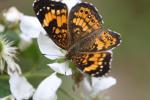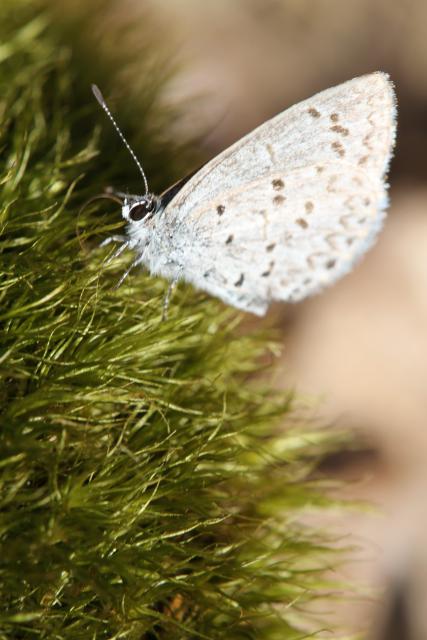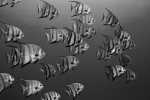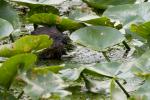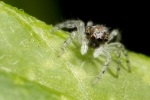insects
Grasshopper at Phipps
ktuli — Wed, 07/21/2010 - 16:01
I don't know if Phipps really likes pests like grasshoppers jumping around their greenhouses, but during out last visit we saw a couple around,
Technical Data: Canon EOS 7D, Tamron 180mm f/3.5 Di SP LD 1:1 Macro, 1/330 sec at f/9.9. ISO Auto. Canon Monopod. Phipps Conservatory, Pittsburgh, PA.
Why This Photo: Seeing this grasshopper in the conservatory was enough of a surprise and different subject for in the gardens, that it was a pleasant alternative to the usual subjects there. I would have liked to have shot with a tripod, but at least the monopod helped a bit.
What Works: I like the tack sharp focus coupled with just the right amount of depth of field. The foreground flower and grasshopper are in focus, but the background is soft and the additional blurred flower provides a nice reference point and additional focal 'distraction' for multiple points for the viewer's eyes to wander to.
What Doesn't Work: The framing might be better slightly pulled back to not cut off the flower in the foreground, or alternatively just a lower angle shot to get more of profile shot of the grasshopper.
Do you see anything you like or dislike about this photo? Drop me a comment and let me know.
- Bill
Metallic Gold Fly
ktuli — Sun, 06/06/2010 - 20:11
Sorry for the abrupt stop in updates. We've been having some water leaking into our basement (in like four different locations) with all this rain we've been having, so we've been spending our evenings and the entire weekend moving things around and cleaning up. I'm pretty exhausted.
So like the other day, I'm just taking the quick easy route and just posting a photo with no critiques or discussion - hope you don't mind.
If you haven't checked out the other posts from this set, scroll down and check out the rest of the posts, or go to the Table of Contents for the full list.

Technical Data: Canon EOS 7D, Sigma 150-500mm f/5-6.3 APO DG OS HSM with Kenko Teleplus PRO 300 "DG" AF 2x Teleconverter at 1000mm, 1/40 sec at f/14.1. ISO 200. Dolica AX620B100 tripod. No post production. Kanawha State Forest, Charleston, WV.
Feel free to post a comment with your own critique of this photo.
- Bill
Resting Gorgone Checkerspot
ktuli — Wed, 06/02/2010 - 17:00
As promised, here's another photo of one of those Gorgone Checkerspot Butterflies. This little guy was willing to let me move in as close as my lens would allow (18.5 inches).
I moved around to a couple different angles and distances, but unfortunately was so focused on the butterfly and getting the images before he flew off that I only came up with this one image that I think works well.
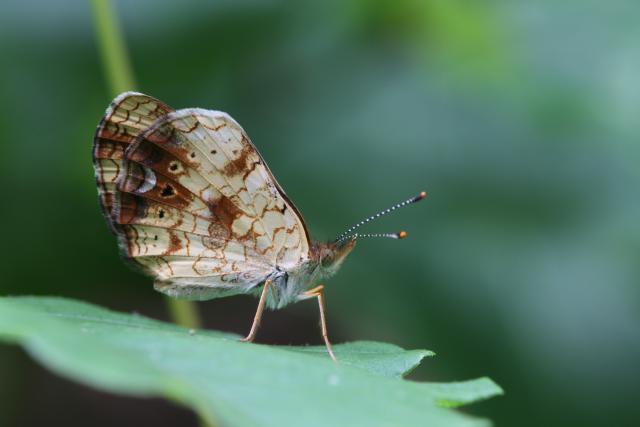
Technical Data: Canon EOS 7D, Tamron 180mm f/3.5 Di SP LD 1:1 Macro, 1/10 sec at f/9.1. ISO 200. Dolica AX620B100 tripod. No post production. Kanawha State Forest, Charleston, WV.
What Works: Focus is tack sharp with enough depth of field to keep most of the butterfly in focus (the very tips of its antennae are slightly blurred). The softly blurred background and framing with the offset butterfly is pleasing.
What Doesn't Work: The bright green grass stem in the background is a slight distraction, and if the antennae tips were in focus would be a bit nicer.
As I said, I took several other exposures of this guy, but none of them were just right. Everyone of them had some semi-major flaw with them that I was displeased with...

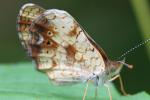
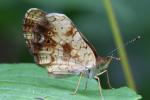
The image on the left has a weird convergence with the antenna tip and the eye of the butterfly. The center image shows my typical problem of cropping too closely in camera and cutting off key elements (antenna tip and feet in this case). While the third image has distracting background elements in a bad location right behind the butterfly's head.
That's why you take multiple exposures with a subject.
- Bill
Simple White & Brown Moth
ktuli — Sun, 05/30/2010 - 12:50
I am resting on the sofa today after getting up really early for 3.5 hours of hockey before it got too ridiculously hot, so I figured I should make another post. I continued scanning through my photos from the Kanawha State Forest in WV. So far, this set has produced posts about a Gorgone Checkerspot Butterfly, my current favorite unidentified green spider, and Apheloria virginiensis millipedes.
Today, I stumbled across this photo that I have overlooked several times already and really don't remember taking...
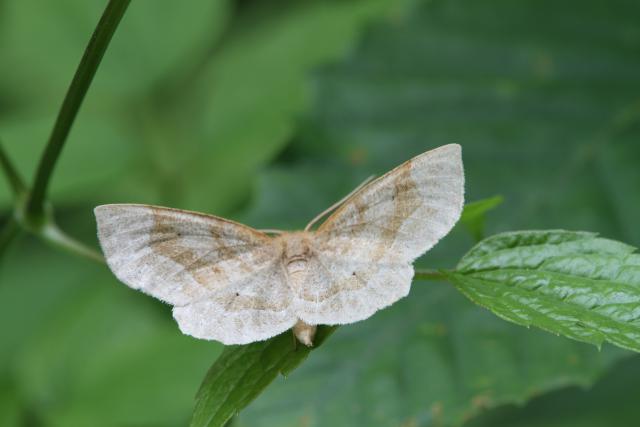
Technical Data: Canon EOS 7D, Tamron 180mm f/3.5 Di SP LD 1:1 Macro, 1/25 sec at f/11.3. ISO 200. Dolica AX620B100 tripod. No post production. Kanawha State Forest, Charleston, WV.
Why This Photo: Honestly. this is basically a one-off photo. I have one other shot of this moth, but I either didn't get much of a chance to or didn't want to spend much time with this subject.
What Works: The biggest thing that struck me with this photo is its simplicity. There is basically just the main subject and nothing else to distract you from it. Yet the photo isn't flat - the blurred background still holds enough to keep (at least my) interest.
What Doesn't Work: Focus is sharp, but it is either slightly forward of where it should be, or I needed a slightly wider depth of field. If you check the full-size version, the head and antennae of the moth are blurred. Kind of minor, but it sure would make a better photo. Also, it would have been nice if I could have gotten the face of the moth in the photo - but sometimes that's easier said than done.
Oftentimes, that one-off photo turns out to be a really nice photo. And many times, simpler is better.
And then there's that whole luck factor... ;)
- Bill
Black and Gold Millipede (Apheloria virginiensis)
ktuli — Thu, 05/27/2010 - 19:46
First, if you have not yet seen the previous posts from this series, you should definitely check them out! The first post has a butterfly shot, and the second post in the series has my current favorite spider photo! Some really awesome stuff you don't want to miss.
I've been wanting to find a millipede to photograph for some time now. As we started our first photo hike through the Kanawha State Forest I quickly saw one of these black and gold millipedes - I have yet to find a common name for them, and doubt everyone will want me to call them Apheloria virginiensis repeatedly. Though I could... a couple years of owning and operating a tropical fish store and hatchery has gotten me pretty fluent with scientific names.

After spotting one, it became quite easy to find many more - they were almost everywhere. I spent multiple attempts trying to capture a good image of one of these guys to little avail. I quickly had to reassess my impression of millipedes as slow and cumbersome critters. These little buggers could sure run - it was pretty difficult to get good focus.
But I tried...
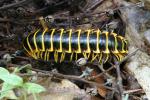
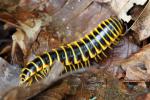
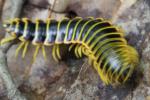
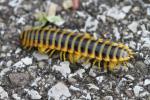
... and tried and tried and tried some more.
Which is why I'm not going to really critique any of these shots. I basically feel at best all I managed was either a record shot or worse - a poorly focused record shot. I spent so much effort trying to track these guys as they ran along the ground, and whenever they did stop I couldn't get them at a good angle to produce a nice photograph (and trying to adjust anything around them - like moving a stick or leaf - caused them to start running again).
With their bright markings, we were pretty cautious about disturbing them too much and didn't want to handle them at all, and it turns out that was a very good idea since they are reported to secrete a cyanide compound as a defense, that while not necessarily deadly would have caused a lot of discomfort and possible injury. In general, remember that bright markings on insects and other animals can often indicate that it is poisonous.
So that will be the lesson for today's photos - have a healthy respect for your subject. Whether for your own safety or for the better well-being of the subject, keep that respect at the forefront of your mind - ahead of even getting that prized image. Especially if you are not familiar with your subject, such as this case, remember to give your subject its space and only observe, and you'll be fine. You might have to go back later to try for another shot later, but there are much worse possibilities.
- Bill
Gorgone Checkerspot Butterfly
ktuli — Tue, 05/25/2010 - 20:51
Anya and I took a trip down to Charleston, WV this past weekend, and so I spent two days taking photographs in Kanawha State Forest. The first day we spent roughly two hours walking just a 0.25 mile trail.
We saw tons of things to photograph because I had our Tamron 180mm Macro lens set on the camera. We spent the entire time looking for tiny critters to photograph - things from butterflies, to frogs, to millipedes, and spiders... tiny flowers, mushrooms, and even some strange wild dwarf strawberries.
Anya really is a great spotter. I love being out on photo excursions with her. She finds a subject for me, then wanders ahead to find another while I set up shop and take some photos. She really helps with my patience to move slower through an area and look at things much more closely - definitely helpful when you're out for macro shots.
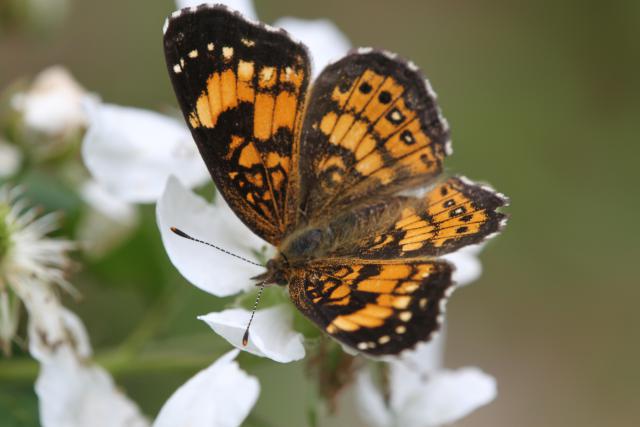
Technical Details: Canon EOS 7D, Tamron 180mm f/3.5 Di SP LD 1:1 Macro, 1/100 sec at f/7. ISO 200. Dolica AX620B100 tripod. No post production. Kanawha State Forest, Charleston, WV.
Why This Photo: We had just hopped out of the truck, and gotten started. There were butterflies all over the place, so what better subject to get started with. Butterflies are incredibly elusive, but so rewarding when you manage to get a good crisp shot.
What Works: I like the soft background of this photo, with enough detail to not be bland and boring. The framing is nice - I had another shot that was slightly crisper in focus, but the edge of the wing got clipped off - this shot has the entire butterfly in the shot, and nicely offset to keep things interesting.
What Doesn't Work: The focus is just the slightest bit soft on the eyes of the butterfly (but you have to look at the full size version to really notice). Additionally, I failed to hit that perfect time when the both wings were parallel to the camera's sensor to produce both wings in focus - this isn't as huge of a deal in my opinion, but a shot with both wings crisp would be worth so much more. And finally, I wish the butterfly had been oriented in a more upright position as opposed to this downward facing direction - but beggars can't be choosers (at least not yet).
Researching more on this butterfly to find the species (Chlosyne gorgone) showed that they are only reported to live in that specific county in WV where the Kanawha State Forest is. They live plenty of other places in the country, but I just happened to get lucky with this one in that area.
They by far were the most abundant butterflies in the park, and were definitely the most cooperative to photograph. I'll have another shot of one that I shot later that day that literally let me move around it and inch closer and closer as if it could care less. I'll share that photo later, I promise.
What do you think of this shot? Maybe compare it to this one to the right which is the one I mentioned that the wing tip got cropped out (darn constantly moving subjects combined with a gentle breeze!).
Leave me a comment and give me a little critique.
And stay tuned as I have many more photos to share from this outing.
- Bill
Moth and Moss
ktuli — Sun, 04/11/2010 - 20:01
Anya and I took another trip out to Deer Lakes Park to see what we could find to shoot. I was mainly looking for more macro photos.
As we walked along, I saw this small bright blue moth fluttering around. I tracked it for a few minutes, then managed to pick it up. This isn't something I do too often, as I try to not impact anything I photograph, but I figured if I could be careful enough to not injure the moth, it would be ok. Maybe this is a technique I can work on improving and using to my advantage.
Once I managed to catch the little guy, he actually seemed very willing to hang out, easily moving from hand to hand if I just put another finger in front of him he would walk up onto it. After looking around for a bit, Anya found a small clump of moss that would work great as a backdrop.
As I held the moth, I noticed his proboscis was scanning over my hand, and I decided I wanted to try and photograph that. Luckily, he continued to search through the moss with his proboscis the same way.
Technical Data: Canon EOS 7D, Tamron 180mm f/3.5 Di SP LD 1:1 Macro, 1/170 sec at f/8. ISO 200. No post production. Deer Lakes Park, Tarentum, PA.
Unfortunately, I didn't do such a great job of getting the shot I wanted. There were a few things I had in mind while taking these photos - some improvements I wanted to make, some things I wanted to try. But at the same time, there where are a couple of things I did wrong, and some things I simply forgot.
- Hand-held Shooting: This is a bad habit that I think I need to break sometime soon. I am not a big fan of the tripod we own (I've been telling myself for a while we need a new one). However, I rarely carry a tripod with me when I head out into the field. I sometimes get away with it, but today was not one of those days.
- Smaller Aperture, Slower Shutter Speed: I've been looking at some of my macro photography, and I'm starting to wish I had used a smaller aperture to capture more depth of field. So today was when I thought to try that. The photo here was shot at f/8. Combine that with my reluctance to carry a tripod, and you increase your chances of blurry photos.
- Poor Framing: This photo is only one out of ten that did not cut off any part of the moth. This is something I'm rather disappointed in myself with. Granted this is something that is easy to do with macro where any movement is exaggerated. But that's really no excuse, I simply wasn't taking the time I should have been to get things lined up.
All in all, I came away with a fairly disappointing set of photos, but some important reminders about things I need to keep in mind when out taking photos. Hopefully next time out, I can work on the juggling act that is remembering all the pieces that need to come together to be able capture that remarkable image.
Have any suggestions for things I could do to improve these photos? Or have any questions about the things I did right or wrong with my shots? Or just want to commiserate about the struggles of macro photography? Leave me a comment and let me know what you think.
- Bill
Aphids on Rosebud
ktuli — Tue, 04/06/2010 - 19:43
I submitted this photo to the Photographic Section's second digital projected image competition of the year.
I really liked this photo. Unfortunately, it didn't do so well in the judging.
Technical Data: Canon EOS Digital Rebel XT, Tamron 180mm f/3.5 Di SP LD 1:1 Macro, 1/250 sec at f/4. ISO 400. No post production. Taken in our backyard.
Why This Photo: I originally was in the yard photographing an insect I had never seen before (but turned out to be a ladybug larva and I'll share some of those photos eventually) when I saw this rosebud covered in aphids. I steadied the lens by leaning against our fence and squeezed off as many photos as I could.
What Works: The focus is tack sharp, and the shallow depth of field produces a perfectly blurred background providing a soft green background. The rose sits on one of the thirds lines with the lean of the rosebud is towards the center of the photo keeping the viewers attention from wandering.
What Doesn't Work: I honestly don't think there is much wrong with this photo. I didn't agree with any of the critiques this photo received at the competition, and since I can't think of any I'll just leave it open.
I did remove the sensor dust spots in the version I submitted for competition. That would be the two dark spots on the left side of the photo. We've since cleaned the sensor on our camera to remove future occurrences of that.
What do you think? Is this photo as strong as I think? Or can you find things you don't like about it?
Leave me a comment and let me know what you think.
- Bill


